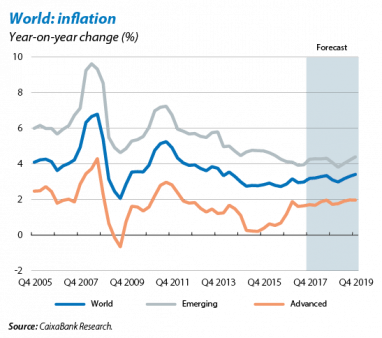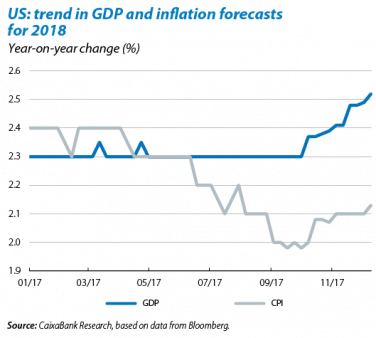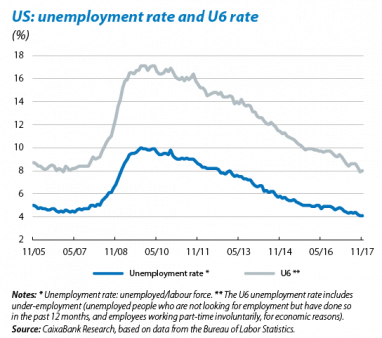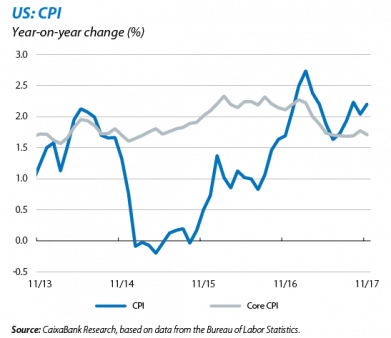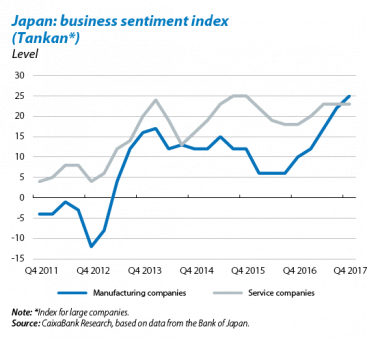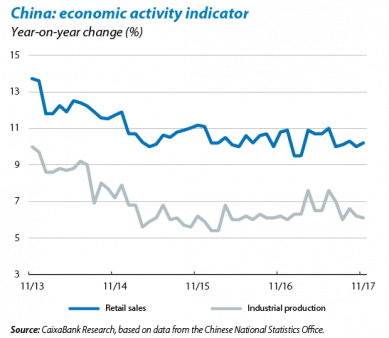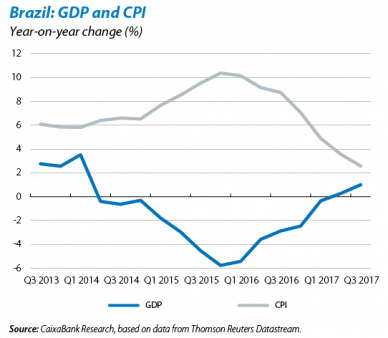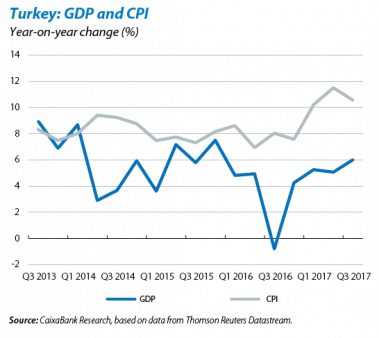Good outlook for 2018
The global economic momentum improves in Q4 2017 and 2018 starts well. Overall, at the end of 2017, global economic data were surprisingly good. This endorses the CaixaBank Research scenario which predicts world growth will continue to speed up slightly from 3.2% in 2016 to 3.6% in 2017 and up to 3.8% in 2018. The global composite business sentiment index (PMI) (including both manufacturing and services) stood at 54.0 points for the October and November average, well within the expansionary zone and clearly above the average of 51.9 points recorded in 2016. At a sector level, in November the manufacturing index reached its highest level since March 2011 while the services index continued to point to significant growth in economic activity.
Macrofinancial risks may cloud these good prospects, however. Apart from the geopolitical, political and commercial aspects mentioned in last month’s Monthly Report, macrofinancial risks remain prominent. There are fears that monetary normalisation, which the Fed is likely to continue, will have a greater impact than expected on world growth. One reason is the high level of global debt, which has continued to grow in recent years, as well as the bullish stock markets in some countries. This could be the case, for example, if US inflation increases more than predicted, forcing the Fed to raise interest rates faster than expected. This cannot be ruled out, particularly as global growth will enter the mature phase of the cycle in the coming years (for more details, see the Dossier «Global macrofinancial risks» in MR12/17).
UNITED STATES
Good prospects for 2018. Throughout 2017, analysts of the US economy have steadily improved their GDP growth forecasts for 2018, encouraged by strong economic growth and, more recently, tax reforms. In mid-December, the House of Representatives and the Senate finally approved the tax reform bill. Among many other aspects, this cuts corporate income tax from 35% to 21% and the maximum individual rate from 39.6% to 37%. In general, this reform is expected to provide a moderate boost in 2018 and 2019 of around 0.2 pp. However, there is considerable uncertainty surrounding these estimates. This is partly because the US economy is at a very advanced stage in its economic cycle, potentially limiting growth and, conversely, pushing up inflation higher than expected.
Sustained growth in economic activity in Q4. The most recent Q4 economic activity indicators continue to point to solid growth in line with that of Q3. The Atlanta Fed’s forecast model (GDP-Now) points to 0.8% growth quarter-on-quarter, matching that of the previous quarter. 228,000 jobs were also created in November, a significant figure especially considering the economy is close to full employment. The unemployment rate remained very low at 4.1% while the broader unemployment rate (U6, which takes into account, among other things, discouraged workers and part-time employees who would like to work full-time) stood at 8.0%, in line with pre-crisis levels.
Inflation remains subdued despite strong growth. Headline inflation stood at 2.2% in November, 0.2 pp above October’s figure while core inflation, less exposed to fluctuations in energy and food prices, stood at 1.7%, 0.1 pp below the previous month’s figure. The price index for personal consumption expenditure, the Fed’s benchmark, stood at 1.6% in October, well below the institution’s target of 2%. However, CaixaBank Research’s forecasts predict that inflation will recover over the next few months, reaching just over 2% by the end of 2018. This is due to the maturity of the US economic cycle and the disappearance of various temporary elements that pushed inflation down in mid-2017.
The Fed boosts confidence in the economy. In December, given the strong performance by the labour market and expected recovery in inflation, the Fed decided to raise the fed funds rate by 25 bp to 1.25%-1.50%, as implied at previous meetings. The institution also presented its new macroeconomic forecasts, with 2018 growth above the country’s potential. This is in line with the estimates by CaixaBank Research, which put annual growth at 2.4% (compared to a potential of 2%).
REST OF THE WORLD
Japan’s Q4 economic activity indicators continue to point to significant growth. The Q4 business sentiment indicator (Tankan) for large manufacturing companies rose to its highest level since December 2006 (25 points) while the index for large service companies remained stable at a high level. The consumer sentiment index also remained high in November.
Economic activity indicators remain firm for China although the government’s restrictive stance is coming to light. The most positive notes in November for the largest emerging market were provided by retail sales and exports. The former rose by 10.2% year-on-year, supported by the success of Singles Day on 11 November. On the external front, exports (in nominal terms and in USD) grew by a considerable 12.3% year-on-year and imports by 17.7%. Industrial production was up by 6.1% year-on-year, a positive figure but clearly lower than the average for the first 10 months of the year (6.7%), hampered by far-reaching anti-pollution measures implemented for industries in northern China. Against this backdrop, at its December meeting the Communist Party’s Politburo set three economic priorities for 2018: mitigating financial risks, reducing poverty and combating pollution. This suggests that, over the coming months, vigorous environmental measures will continue and economic stimuli reduced. This more restrictive stance could impact economic growth although we expect the effect to be moderate.
Brazil, Latin America’s leading economy, continues to recover but very slowly, in the face of weak investment and public consumption. GDP grew by 1.4% year-on-year in Q3, more than the 0.4% growth in Q2 but still 5.5% below the levels of late 2014, before the strong recession. This recovery is likely to continue in the short term. Nevertheless, the political situation (the government’s legislature is coming to an end) and uncertainty regarding the important outcome are likely to postpone spending and investment decisions, keeping growth relatively contained.
Turkey outperforms all expectations. Turkish GDP grew by 11.1% year-on-year in Q3 2017 (5.4% year-on-year in Q2). Although this figure is altered by a base effect (in Q3 2016 there was a significant drop in GDP after the attempted coup), the economy has undoubtedly been more dynamic than expected. Although the year-on-year growth rate will probably slow down in Q4, 2017 is likely to be the most dynamic year of the past four. However, the outlook for 2018 points to a clear slowdown in growth due to the accumulation of significant macroeconomic imbalances. In November, inflation stood at a high 13% (an all-time high for the series) while the current account balance was –4.7% of GDP in Q3 (compared to –3.7% at the end of 2016).

